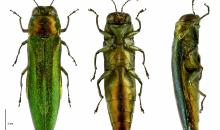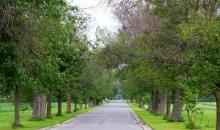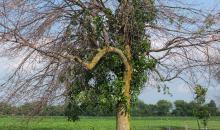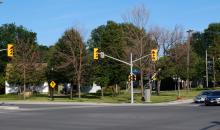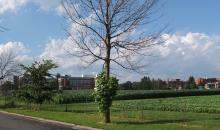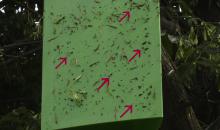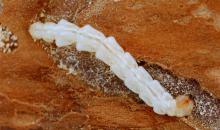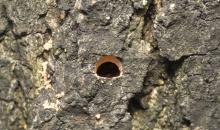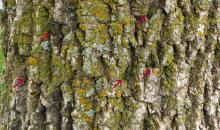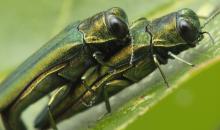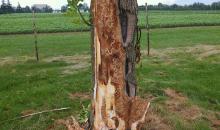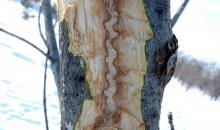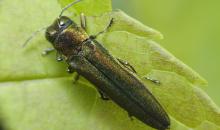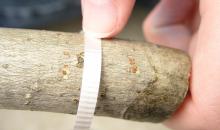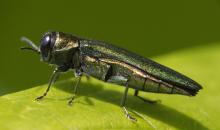Agrilus planipennis(AGRLPL)
Photos
For publication in journals, books or magazines, permission should be obtained from the original photographers with a copy to EPPO.

Exit hole (Ottawa, June 2010)
Courtesy: Jean-François Germain - Plant Health Laboratory, Montpellier (FR)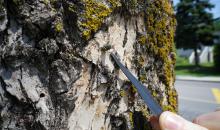
Adult (Ottawa, June 2010)
Courtesy: Jean-François Germain - Plant Health Laboratory, Montpellier (FR)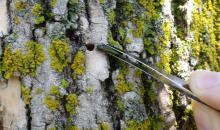
Exit hole and adult (Ottawa, June 2010)
Courtesy: Jean-François Germain - Plant Health Laboratory, Montpellier (FR)
Exit holes (Ottawa, June 2010)
Courtesy: Jean-François Germain - Plant Health Laboratory, Montpellier (FR)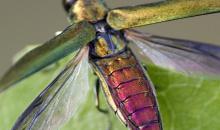
EAB is strong flier. During the flight, the contrast purple abdomen is exposed.
Courtesy: Eduard Jendek
Nymph of the spined soldier bug (Podisus maculiventris) found in EAB an easy prey
Courtesy: Eduard Jendek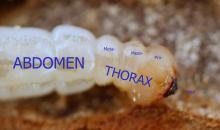
Head is retracted into 3 segmented thorax. The rest of the body is 10 segmented abdomen
Courtesy: Eduard Jendek
Except for exit holes, an attack is indicated by cracks and changes in bark color
Courtesy: Eduard Jendek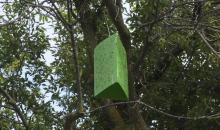
The three-sided green sticky prism traps are widely used for prediction and monitoring of EAB
Courtesy: Eduard Jendek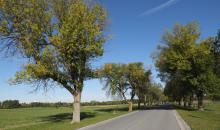
Ottawa, September 2012. The first symptoms of infestation. Untimely yellowing and thinning of foliage caused by larval activity
Courtesy: Eduard Jendek
Egs are laid by a long mebraneous telescoping ovipositor allowing precise oviposition deep into bark crevices
Courtesy: Eduard Jendek
Larva of all Agrilus species is distinctive by abdominal apical pair of serrate styles
Courtesy: Eduard Jendek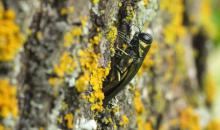
Oviposition occurs in the later part of warm, sunny days. Females lay egs in the obscure places in the bark.
Courtesy: Eduard Jendek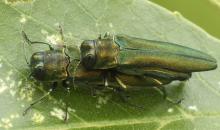
During the mating, the male is hooked on the female by first two pairs of legs ...
Courtesy: Eduard Jendek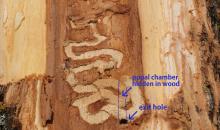
Mature larva pupates in the pupal chamber, adult beetle emerges through exit hole
Courtesy: Eduard Jendek
Larval S-shaped, frass-filled tunnels are visible on inner bark and outer sapwood
Courtesy: Eduard Jendek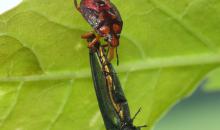
The spined soldier bug (Podisus maculiventris) is a generalist predator with a broad host range. This is the first proof it attacks also EAB
Courtesy: Eduard Jendek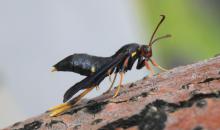
Ash borer moth (Podosesia syringae) loves weakened ashes. Its presence may indicate A. planipennis infestation
Courtesy: Eduard Jendek
To reach sexual maturity, both sexes feed on the ash foliage. This type of leaf damage is defined as "margin feeding". Feeding is often accompanied by characteristic droppings
Courtesy: Eduard Jendek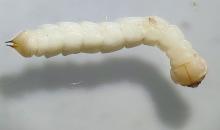
A larva of A. planipennis, Coll. by Yu.N. Baranchikov, Tombov, Russia, 2017
Courtesy: Natalia Kirichenko (Sukachev Institute of Forest, SB RAS, RU)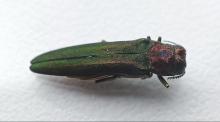
An adult of A. planipennis, Coll. by Yu.N. Baranchikov, Tombov, Russia, 2017
Courtesy: Natalia Kirichenko (Sukachev Institute of Forest, SB RAS, RU)
Same ash lined street after infestation by Agrilus planipennis.
Courtesy: Daniel A. Herms, The Ohio State University (US).
